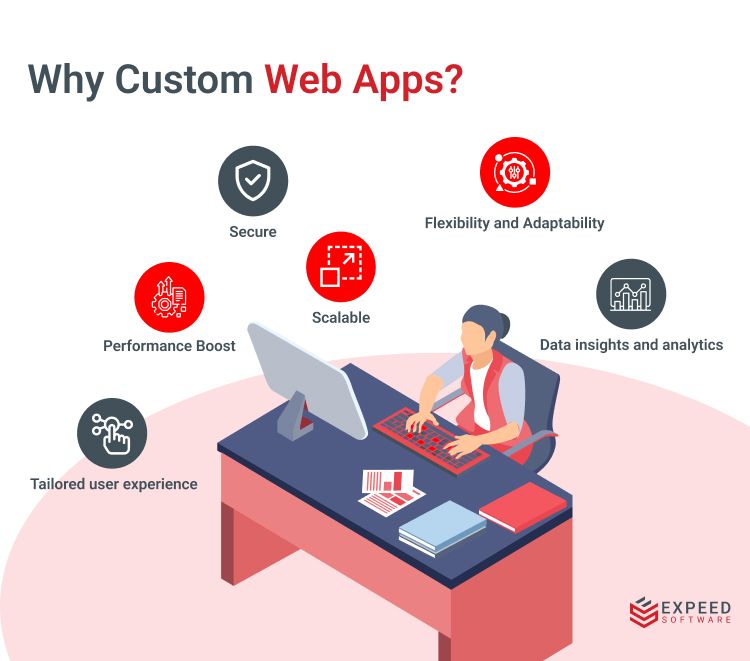A Comprehensive Handbook for Custom Web App Development
In today’s age, businesses are navigating a landscape of both opportunities and challenges. The days of one-size-fits-all solutions are long gone. That’s where custom web application development comes in to save the day.
Tailored solutions hold the key to address constantly evolving business needs. Since no two businesses are identical, trying to force them into pre-cast solutions only leads to frustration. That is where custom web applications come into play – they are customized tools engineered to tackle each business’s challenges specifically. Whether it involves complicated processes, refining customer interactions, or propelling growth, custom web apps are tailor-made to deliver results that truly resonate with each business’s essence.
How did we arrive at this point? The journey of web applications began with web pages and gradually transformed into dynamic and interactive applications. From the days of HTML dominance to the emergence of AJAX and Web 2.0 technologies, the evolution of web apps has been nothing but remarkable.
As web app development companies strive to differentiate themselves and provide their customers personalized options, custom web apps are now a necessity rather than a passing trend. Embracing customization will not only enable a business to adapt to the changing market but also facilitate more effective customer engagement by giving them an advantage over their competitors.
In this article, we will explore the realm of tailored web applications, their significance in meeting business needs, and their crucial role in fostering innovation to achieve success. So buckle up and get ready for a journey into the world of customized web applications!
Why are Custom Web Apps Important?
Custom web applications are meant to meet the unique demands and objectives of individual businesses. Let us delve into the core aspects of custom web applications, seeping through their layers and exploring their indispensable role in modern business environments.
A custom web application development company creates focused software solutions specifically designed to align with requirements and workflows of a particular business entity. Unlike off-the-shelf solutions, which offer standardized features and functionalities, custom web applications are tailored from scratch. They are conceptualized, designed, and developed with a deep understanding of the client’s needs, resulting in a solution that is precisely shaped to address their unique challenges and aspirations.

The advantages of custom web applications over generic solutions are:
Tailored Solutions: Custom web applications offer a level of customization and flexibility that generic solutions cannot provide. They are finely tuned to address specific business requirements, providing a tailored solution tailored to fit chosen businesses.
Enhanced Performance: Custom web applications are optimized for delivering boosted performance, ensuring faster response times, improved scalability, and a seamless user experience to meet specific business needs.
Seamless Integration: Custom web applications can be seamlessly integrated with existing systems, databases, and third-party services, enabling businesses to leverage their existing infrastructure and workflows without disruption.
Scalability and Growth: Custom web applications are designed to scale along with the growth of the business, accommodating increased user traffic, data volumes, and functionality requirements over time.
Competitive Advantage: By offering unique features, functionalities, and user experiences, custom web applications empower businesses to differentiate themselves from competitors and establish distinct traits.
Security and Compliance: Custom web applications can be fortified with robust security features and compliance measures tailored to the specific requirements of the business, ensuring data protection, regulatory compliance, and risk mitigation.
The real-world impact of custom web applications is profound, with businesses across diverse industries reaping the benefits:
E-commerce Platforms:
- Personalized shopping experiences
- Effective order management
- Optimized inventory control.
Healthcare Providers:
- Patient record management
- Appointment scheduling
- Telemedicine consultations
Financial Institutions:
- Online banking
- Payment processing
- Fraud detection
Educational Institutions:
- Student enrollment
- Course management
- Online learning platforms
Manufacturing Companies:
- Supply chain management
- Production scheduling
- Quality control
Custom Web App Development Lifecycle
The process of developing a custom web application involves a sequence of interconnected stages that are crucial for the completion of the end product:
- Planning: The journey begins with meticulous planning, where stakeholders define project objectives, scope, and deliverables. Clear goals and timelines are established to guide the development process forward.
- Design: With a solid plan in place, attention turns to the design phase, where wireframes, prototypes, and mockups are crafted to visualize the user interface and user experience. Designers work closely with stakeholders to refine concepts and ensure alignment with the project vision.
- Development: Just like soldiers armed with a blueprint, developers spring into action, bringing the design to life through coding and implementation. This phase involves building the core functionality of the custom web application while adhering to coding standards and best practices.
- Testing: Quality assurance takes center stage as the application undergoes rigorous testing to identify and address any bugs, errors, or performance issues. Testing ensures that the application functions seamlessly across different devices, browsers, and operating systems
- Deployment: With thorough testing complete, the custom web application is ready to be deployed into a production environment. The deployment process involves configuring servers, setting up databases, and optimizing performance to deliver the best user experience.
- Maintenance: Even after deployment, the journey continues with ongoing maintenance and support. Developers monitor the application for potential issues, implement updates, and respond to user feedback to ensure continuous improvement.
Why is Requirement Gathering Important in Web App Development?
At the heart of custom web app development lies the crucial process of requirement gathering and analysis. This phase serves as the foundation upon which the entire project is built.
- Understanding Business Objectives: Developers collaborate closely with stakeholders to gain a deep understanding of the business objectives, user needs, and technical requirements.
- User Stories and Use Cases: Through in-depth discussions, workshops, and consultations, developers identify user stories and use cases to capture the functional and non-functional requirements of the application.
- Scope Definition: The scope of the project is defined, outlining the features, functionalities, and constraints that will shape the development process.
- Documentation: Requirements are documented in detail, providing a roadmap for developers and ensuring alignment with the client’s vision and goals.
Custom Web App Development Methodologies
Custom web app development companies depend on a variety of methodologies, each offering a distinct approach to project management and execution.
- Agile Methodology: The agile approach ensures flexibility, collaboration, and iterative development of a project. It facilitates continuous feedback and adaptation, enabling teams to respond quickly to changes and deliver an effective product to stakeholders.
- Waterfall Methodology: The waterfall model is known for its sequential development approach. The phases of the waterfall method can be split into requirements gathering, design, development, testing, and deployment. It provides a structured framework for projects and minimal changes are bound to occur during the development process.
- Hybrid Approaches: Some projects may benefit from a hybrid approach that combines elements of Agile and Waterfall methodologies, allowing flexibility and adaptability while maintaining a structured framework for planning and execution.
What are the Technologies used in Custom Web App Development?
In the digital world, where custom web applications flourish, a wide range of technologies come together to lay the foundation for their creation. These technologies, although intricate, in their mechanics drive the delightful experiences that users indulge in on a daily basis. Now let’s delve deeper into the elements that enable the development of customized web applications.
1.Frontend Technologies:
In the world of user interaction, front-end technologies play a role in determining how custom web applications appear, function, and create an impact. Popular technologies like HTML, CSS, and JavaScript serve as the foundation for developers to design user interfaces and captivating experiences that engage users.
2. Backend Frameworks:
Behind the scenes, there are frameworks such as Node.js, Django, and Ruby on Rails that empower custom web applications. These frameworks offer the infrastructure to handle user requests, handle data management, and efficiently coordinate tasks. By utilizing the capabilities of these frameworks developers can optimize their processes thereby providing reliable and scalable solutions.
3. Database Management:
Databases have a notable role in the storage organization and retrieval of data for customized web applications. Popular technologies like MySQL and MongoDB offer solutions for managing data. Whether it is storing user details, handling inventory, or keeping track of transactions, databases serve as the foundation for applications that rely on data guaranteeing access to information whenever required.
4. Server Architecture:
Choosing the right server architecture is vital, for guaranteed dependability, scalability, and efficiency of web applications. Cloud-based solutions provided by companies such as AWS (Amazon Web Services) and Azure offer an infrastructure for hosting web applications. By utilizing cloud-based services, businesses can achieve accessibility with lower infrastructure expenses.
5. Emerging Technologies:
In the dynamic landscape of the digital world, new technologies play a pivotal role in shaping the future of online experiences. Progressive Web Apps (PWAs) provide a distinct experience to users that seamlessly blend the advantages of both web and native apps.
By streamlining infrastructure management tasks, serverless architecture, which relies on platforms such as AWS Lambda and Azure makes development more straightforward. Additionally, microservices architecture allows developers to divide applications into components promoting flexibility and scalability.
Such technologies behind custom web app development form a sophisticated ecosystem that empowers developers to create innovative, user-centric solutions. By embracing the latest trends and technologies, businesses can unlock new possibilities and stay ahead in today’s competitive digital landscape.
What are the Key Features and Functionality of Custom Web Applications?
Custom web application development plays a role in propelling businesses forward by providing personalized solutions that cater to a wide range of needs and obstacles. In this section we explore the attributes and benefits of custom web applications, under various scenarios, emphasizing the importance of scalability, security, and optimized performance.
1.Use case-driven features:
Custom web applications are designed to cater to specific business requirements across a wide variety of use cases. For instance:
E-commerce: Custom web app development may include features such as product catalog management, secure payment gateways, order processing, and customer relationship management (CRM) integration.
Social Networking: The application’s functionality could encompass user profiles, messaging systems, content sharing, and social engagement analytics.
Project Management: The app’s essential features might include task tracking, milestone management, collaboration tools, and reporting capabilities.
Each use case demands a unique set of features tailored to optimize workflows and enhance user experiences.
2. Scalability, Security, and Performance Optimization:
Scalability: The developers strive to ensure that applications can effortlessly adapt to accommodate the increasing demand while maintaining optimal performance. The ability of an application to gracefully handle expanding user loads over time and facilitate growth is a big perk for the development team.
Security: Robust security measures are essential to protect sensitive data and ensure user privacy in custom web apps. Features such as user authentication, data encryption, access controls, and vulnerability assessments avoid security risks.
Performance Optimization: A custom web application optimizes performance to deliver a smooth and responsive user experience. Techniques such as caching, code optimization, database indexing, and content delivery network (CDN) integration minimize load times and enhance overall performance.
By prioritizing scalability, security, and performance optimization in custom web app development, businesses can build reliable, efficient applications that meet focused requirements.
Security and Compliance in Custom Web App Development
Ensuring the security and compliance of custom web app development is of prime importance for companies. It involves safeguarding data and adhering to standards. In this section, we will delve into security threats, compliance requirements, recommended measures to manage risks effectively, and maintaining strong security protocols.
1. Common Security Threats and Mitigation Strategies:
Web applications face security risks, which comprise SQL injection site scripting (XSS) and cross-site request forgery (CSRF). These vulnerabilities can jeopardize the integrity of data, confidentiality, and privacy of users. To minimize these risks developers need to incorporate security measures such, as:
- Input validation and parameterized queries to prevent SQL injection attacks.
- Sanitizing user input and implementing output encoding to mitigate cross-site scripting vulnerabilities.
- Implementing secure authentication mechanisms, access controls, and session management to thwart unauthorized access.
- Regular security testing and code reviews to identify and address potential vulnerabilities proactively.
2. Compliance Requirements and Implications:
Custom web applications must adhere to various compliance standards and regulations, depending on the industry and geographical location. For example:
- GDPR (General Data Protection Regulation) mandates strict requirements for the handling and processing personal data by European Union residents.
- HIPAA (Health Insurance Portability and Accountability Act) sets standards for protecting sensitive patient health information in the healthcare industry.
- PCI DSS (Payment Card Industry Data Security Standard) governs the secure handling of credit card information in payment processing systems.
3. Importance of Secure Coding Practices and Security Audits:
Secure coding practices are fundamental to custom web app development, ensuring solid protection of codebases. Key practices include:
- Applying the principle of least privilege to restrict access to sensitive resources.
- Regularly updating dependencies, libraries, and frameworks to address security vulnerabilities.
- Conducting thorough security audits and penetration testing to identify and remediate potential weaknesses.
- Implementing encryption for data at rest and in transit to safeguard sensitive information from unauthorized access.
By integrating secure coding practices and conducting regular security audits, custom web applications can enhance resilience and avoid the risk of security breaches and data compromises.
Deployment and Maintenance of Custom Web Applications
Deployment and maintenance are two critical phases in the life cycle of custom web applications, ensuring seamless operation, optimal performance, and continuous improvement. In this section, we explore deployment strategies, the importance of ongoing maintenance, and tools for monitoring performance and user feedback of custom web apps.
1. Overview of Deployment Strategies:
Custom web applications leverage various deployment strategies to streamline the release process and ensure smooth transitions from development to production environments. Key deployment strategies include:
Continuous Integration/Continuous Deployment (CI/CD): The CI/CD pipelines automate the build, testing, and deployment processes, enabling rapid and reliable delivery of updates and features.
Blue-Green Deployment: A Blue-green deployment is a method that involves maintaining two identical production environments (blue and green) thereby allowing seamless deployments with minimal downtime.
Canary Deployment: A canary deployment is a method that introduces updates to a group of users. This approach enables monitoring and proactive resolution of any problems before the updates are fully deployed to everyone.
By adopting deployment strategies tailored to specific requirements, custom web applications can avoid disruptions and ensure consistent delivery of high-quality software.
2. Importance of Ongoing Maintenance and Support:
Ongoing maintenance, updates, and support are essential to the longevity and effectiveness of custom web applications. Benefits include:
- Bug fixes and security patches to address vulnerabilities and ensure data integrity.
- Compatibility updates to support new browser versions, operating systems, and third-party integrations.
- Performance optimization to enhance user experience and responsiveness.
- User support and training to address inquiries, troubleshoot issues, and maximize user engagement.
By prioritizing ongoing maintenance and support, custom web applications can remain secure, reliable, and responsive to evolving business needs and user expectations.
3. Tools and Techniques for Monitoring and Iteration:
Custom web applications leverage a variety of tools and techniques to monitor performance, analyze user feedback, and iterate on features. These include:
- Application Performance Monitoring (APM) tools for real-time monitoring of application performance metrics, server health, and user interactions.
- User feedback mechanisms, such as surveys, feedback forms, and analytics tools, can be used to gather insights and identify areas for improvement.
- Iterative development methodologies like Agile and Scrum, emphasize continuous feedback, iteration, and adaptation based on user and stakeholder input.
By leveraging these tools and techniques, custom web applications can identify bottlenecks, address usability issues, and evolve iteratively to meet changing business requirements and user expectations.
Wrapping Up
The exploration of custom web app development reveals an array of possibilities for businesses to succeed in this age. Starting with web pages and progressing to dynamic, personalized experiences offered by modern custom web applications, the transformation has been truly remarkable.
By embracing the technologies, methodologies, and industry best practices, companies specializing in custom web app development can unlock a new realm of possibilities. This allows them to stay ahead in the digital landscape while driving innovation. From e-commerce platforms and healthcare providers to institutions and educational organizations, custom web applications are revolutionizing industries. They are reshaping the way businesses interact with their customers.
Looking towards the future, Expeed Software remains committed to the mission of providing state-of-the-art custom web applications that inspire and elevate businesses to levels of success. We invite you to join us on this journey as we redefine what is possible, in the field of custom web app development.




